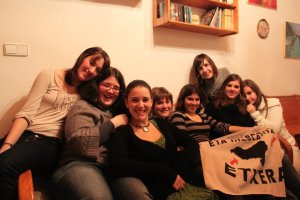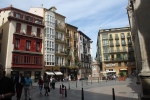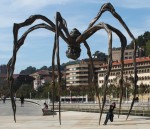Just like in ordinary life, sometimes you have to make tough decisions while abroad. I’d been looking forward to the upcoming International Student Farewell Dinner for weeks, just as I’d been looking forward to my friend Ainhoa’s birthday party. I’d submitted photos to the farewell slideshow, RSVPd on Facebook, and bought Ainhoa a birthday present. Then, the day before the dinner, I got a phone call from one of Ainhoa’s friends. The two events were going to be held the same day, the same time.
It wasn’t a fun decision to make, but I knew from the moment I got the phone call what I would decide. Ainhoa had been a great friend to me. Of all the locals I’d met, she’d made the most sincere effort to include me and show me her culture. I couldn’t miss her birthday, not even for a tear-filled slideshow where all the international students would probably sing along to “as we go on, we remember, we will still be, friends forever…” (and really, what else can happen at an event like that?)
So, I went to Ainhoa’s party. I was meant to meet with the girls who lived on my side of town so that we could take the bus to Txantrea together. I arrived at the designated place at the designated time. It was a cold night, and generally arriving right on time in Spain means you will be waiting 10-15 minutes, but I decided to play it safe because I was meeting with Basques (northern Spanish cultures are a bit less relaxed about time), and because it was a surprise birthday party. After several minutes, another girl who was waiting approached me and asked whether I was Miranda. We chatted and laughed at ourselves for arriving ‘early’ until Andrea came out of her apartment at last. By then we had missed two buses, and since they only come every 15 minutes, we were over an hour late to arrive in Txantrea.
On the way from the bus stop, we suddenly heard cowbells sounding through the otherwise quiet night. To my delight, a parade of Basque Joaldunak ran by! These are dancers who wear cones and ribbons on their heads, costumes of bandanas and wool skirts, and, best of all, two enormous cowbells strapped to their backsides. “Why are they here?” I asked. “To scare away evil spirits!” said Andrea. I laughed at that. “Okay. But why here, and right now?” She just smiled and shrugged.
 We met up with the rest of the group and headed to a bar. As we approached, I once again heard the clanging of cowbells. The Joaldunak were taking a break and a beer inside! It was a tiny place, with Basque independence posters joining calls to socialism, vegan-ism, and the legalization of marijuana on its walls. I worked up my courage to ask one of the Joaldunak for a picture. He was so excited that I spoke a little bit of Basque, that soon he was teasing me and telling me I could play with his bells. Awkward in a way but way too much fun to resist!
We met up with the rest of the group and headed to a bar. As we approached, I once again heard the clanging of cowbells. The Joaldunak were taking a break and a beer inside! It was a tiny place, with Basque independence posters joining calls to socialism, vegan-ism, and the legalization of marijuana on its walls. I worked up my courage to ask one of the Joaldunak for a picture. He was so excited that I spoke a little bit of Basque, that soon he was teasing me and telling me I could play with his bells. Awkward in a way but way too much fun to resist!
After some time in the bar, we went back to a friend’s place. This was actually my first and only time in a private house in Spain! (Within Pamplona, it’s all apartments.) We cooked sausages and croquettes to eat with bread and good Navarran cheese. Everyone wanted to play cards, but after a round or two of playing some Spanish game I never really got the hang of, they asked for an American card game. Okay, fine, but they didn’t have what we would call a ‘standard’ deck of cards – only a set of Mus cards, with less royalty than our decks and suits of coins, swords, cups, and wands, like in tarot.
Towards the end of the party, I gave Ainhoa the present I’d put together for her – some large print photos I had taken of her the day we went to the Cantabrian Sea. Ainhoa and her friends had a present for me as well! I had misunderstood a certain Basque political poster, often hung out of people’s windows in Pamplona and elsewhere, to simply mean, “The Basque Country is awesome!” They all thought this was very funny, and bought me one of these flags. Everyone signed it for me as well.
Zorionak, Ainhoa, eta Mesedez!
Happy Birthday, Ainhoa, and Thank You!








 From the Old Town, with the winding alleys and pintxos bars I’ve already come to expect from Basque Spain, all the way to the famous Guggenheim, I wasn’t disappointed by an inch of the Bilbao I explored. I suppose it could be said that I was only really ‘impressed’ by Bilbao’s riverside market (the largest covered market in Europe), the pintxos at Bar Irrintzi (amazing), and, yes, the world famous Guggenheim Museum, but the spaces in between held their own charm. Our walk through the center of town took us past dozens of cheerful parks and row after row of elegant buildings, and our stroll alongside the Nervión river revealed fascinating, if puzzling, designs of office buildings, bridges, and modern art statues. A shameless mountain geek, I also loved the way the city is nestled down between two mountain ranges, earning it the nickname El Botxo – “the hole”.
From the Old Town, with the winding alleys and pintxos bars I’ve already come to expect from Basque Spain, all the way to the famous Guggenheim, I wasn’t disappointed by an inch of the Bilbao I explored. I suppose it could be said that I was only really ‘impressed’ by Bilbao’s riverside market (the largest covered market in Europe), the pintxos at Bar Irrintzi (amazing), and, yes, the world famous Guggenheim Museum, but the spaces in between held their own charm. Our walk through the center of town took us past dozens of cheerful parks and row after row of elegant buildings, and our stroll alongside the Nervión river revealed fascinating, if puzzling, designs of office buildings, bridges, and modern art statues. A shameless mountain geek, I also loved the way the city is nestled down between two mountain ranges, earning it the nickname El Botxo – “the hole”.











